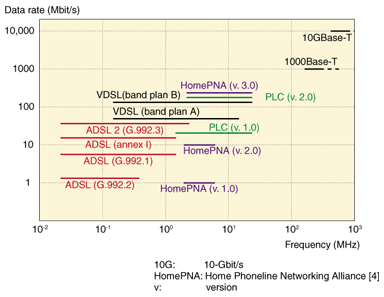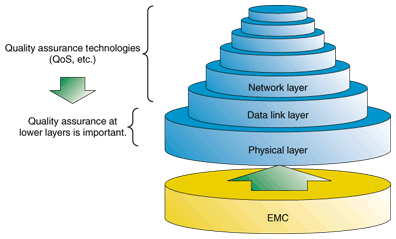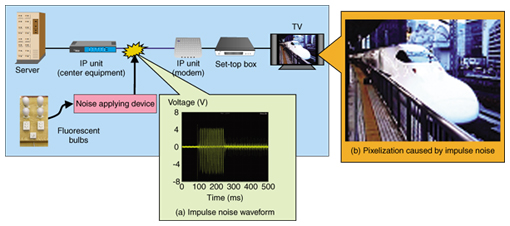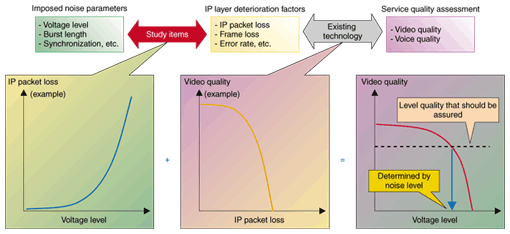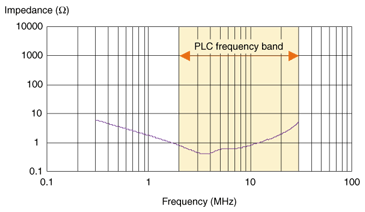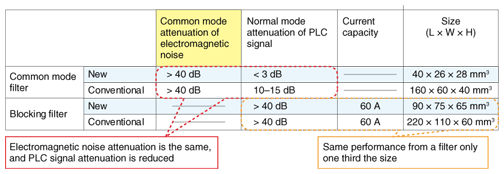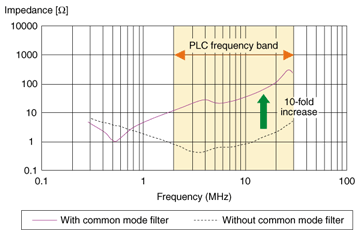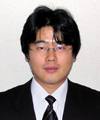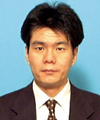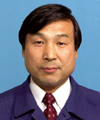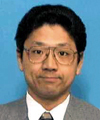 |
|||||||||||||||
|
|
|||||||||||||||
|
Special Feature: EMC Technology for IP Network Infrastructure Vol. 5, No. 12, pp. 45–51, Dec. 2007. https://doi.org/10.53829/ntr200712sf2 IP Broadband Services and EMC in the User EnvironmentAbstractThis paper describes electromagnetic compatibility (EMC) issues related to IP (Internet protocol) broadband services in the user environment. We explain our research results, issues to be solved, and standardization activities with the examples of power line communication and IP streaming services.
1. Broadband communications and EMCAs Internet usage continues to spread, the NTT Group has remained at the forefront with initiatives to upgrade and extend the communications infrastructure and provide attractive broadband service offerings. Thus, we have seen a great increase in the number and types of devices connected to the Internet and an equally diverse range of wired and wireless communications technologies deployed in customers' premises. An overview of the transmission speeds and frequency bands of wired broadband communications services now available to residential subscribers is shown in Fig. 1. The frequency ranges have been increased along with the data rates. In terms of cabling, there has been not only increased use of UTP (unshielded twisted pair) cables, such as for local area networks, but also increased reuse of existing cables in homes, such as metallic telecommunication lines, power lines, and coaxial cables. Wireless communications shows the same trend toward higher signal and carrier frequencies as data rates have increased.
In addition to wired and wireless communication devices connected to an IP (Internet protocol) network, TVs and other kinds of consumer electronics devices are also being connected to the network. All these electronic devices and electrical appliances are being brought closer together and are being used in closer proximity than ever before within homes. This development raises important concerns about electromagnetic compatibility (EMC) because of the potential adverse effects of unintended electromagnetic disturbances emitted from the different kinds of equipment in the home. Therefore, with the increasing popularity and penetration of home networks, the problem of EMC will become serious. 2. Service quality and EMCConsiderable work is underway on quality of service (QoS) in the upper layers of the OSI (Open Systems Interconnection) reference model to ensure the quality of IP network telecommunications, as shown in Fig. 2 [1]. However, these quality control technologies must be based on assured quality in the lower physical and data link layers. Indeed, the issue of EMC is directly connected to the physical layer, which is important to bear in mind when considering the quality of telecommunications.
3. Impulse noise effectsRequirements for the immunity of telecommunications equipment to electromagnetic disturbances are defined by international standards, domestic Japanese standards, and within NTT by the company's own technical requirements [2]. Nevertheless, in the field, we have seen instances of IP equipment failing as a result of impulsive noise triggered by a consumer electronic device being turned on or off. Therefore, robust impulse protection solutions have become an urgent concern. For example, we have seen cases of VDSL (very-high-bitrate digital subscriber line) links being interrupted by impulse noise from defective fluorescent lights, equipment malfunctioning when leased lines have been converted to IP links because of impulsive noise from an elevator, and frequent failures resulting from switchovers to backup systems. Moreover, in other countries, impulsive noise has caused video pixelization in IPTV broadcast services provided by ADSL (asymmetric digital subscriber line), so figuring out how to resolve these issues is perplexing. What all these cases have in common is that impulsive noise—unwanted almost instantaneous noise spikes—from an electrical appliance or consumer electronics device in a user's home environment caused another service or piece of equipment to malfunction. Video communication and similar services can be especially vulnerable to impulsive noises because such services require realtime operation and demand a high standard of reliability. Although current standards require uninterrupted normal operation in the presence of a continuously emitted disturbance, they permit interruptions when impulsive noise occurs. A key issue for ensuring the electromagnetic compatibility of IP networks is therefore to bring the requirements of EMC standards into line with the requirements of video and other services that demand high realtime reliability. 4. Video quality assessment and EMC conditionsWe set up an experimental system for simulating realtime video streaming services, as shown schematically in Fig. 3. Impulsive noise is applied to the transmission line. For the noise source, we used four ordinary household florescent light bulbs. Impulsive noise was produced by turning the lights on and off, and the noise was imposed on the telecommunication line by a noise applying device. The generated impulsive noise is shown in Fig. 3(a) and the resulting video pixelization is shown in Fig. 3(b). For our experimental purposes, the video streaming system was intentionally not equipped with retransmit request capabilities, so the adverse effects of the noise imposed on the line were clearly manifested as disturbances and pixelization of the video image. These results clearly show the importance of clarifying the relationship between EMC conditions and service quality conditions.
There has been a lot of research on the relationship between the factors causing IP layer deterioration (e.g., packet loss) and video quality [3]. Likewise, we attempted to determine the relationship between EMC conditions and IP layer degradation factors, as shown in Fig. 4, in order to clarify the relationship between EMC conditions and video quality degradation. Although we have only just begun to address this issue, we are confident that it will lead to the development of new technologies that are urgently needed to upgrade the reliability of IP services.
5. EMC problems and high-speed power line communicationsIn this section, we describe our recent development of filters that solve EMC problems associated with high-speed power line communications (PLC) and support the provisioning of IP broadband services to residential subscribers. PLC, which is also known as PLT (power line telecommunication) is a new way to deliver telecommunication services over existing power lines using the high-frequency range from 2 to 30 MHz. It started to be deployed inside buildings in October 2006 following revision of Japan's Radio Law. Here, we focus on the key concern about EMC and PLC—the effects of electromagnetic waves leaking from PLC facilities on amateur radio, shortwave broadcasting, and other existing wireless systems—and show how the level of electromagnetic leakage can be effectively limited so that PLC is compatible with existing services. However, EMC issues associated with PLC go beyond electromagnetic leakage. For example, if a PLC modem is deployed in a home, as shown in Fig. 5, the PLC data rate could be adversely affected by electromagnetic noise from electrical appliances connected to the power line or by a connected low-input-impedance device (1). Another problem scenario occurs when a PLC signal propagating over the power line is induced onto the power line of an appliance, causing it to malfunction (2). And finally, if another building (on the left in Fig. 5) is served by the same transformer on a utility pole, the PLC signal to that building might interfere with the PLC signal to the building we are considering because the signal is being delivered to the power line inside the building via the distribution panel. This would also cause the data rate to deteriorate (3).
Regarding the potential adverse affect on the data rate of plugging in a low-input-impedance device, we found that the worst slow-down effects came from plugging a small battery charger, e.g., mobile phone charger, into an outlet in close proximity to the PLC modem. Consequently, we have added a warning to that effect in the modem setup and instruction manual. Small electronic battery chargers use switched-capacitor AC-DC converters to achieve more compact implementations. But if a capacitor-input-type rectifier with a capacity of 2 µF is used for the converter's input, this causes the input impedance of the PLC signal bandwidth (2 to 30 MHz) to fall. A typical measured input impedance for a small battery charger is shown in Fig. 6. The input impedance for the 2–30-MHz band is reduced to as low as 0.5 Ω. If a low-input-impedance device of this kind is plugged into a socket near a PLC modem, current flows to the lower impedance, so much of the incoming PLC signal flows to the charger, and this degrades the data rate.
6. Development of EMC filters for PLCTo remedy the EMC-related problems illustrated in Fig. 5, we have developed two EMC filters for PLC use. First, we developed a common mode filter to reduce the effects of electromagnetic noise and connected low-input-impedance devices ((1) in Fig. 5) and the adverse effects of PLC signals on consumer electronic devices (2). Then, we developed a blocking filter to minimize adverse interference from PLC signals coming from other buildings (3). The common mode filter is designed to reduce electromagnetic noise greatly without attenuating PLC signals, even though they are in the same frequency band of 2 to 30 MHz. This represents a major improvement over existing filters, which are unusable because they attenuate both the noise and the PLC signals. The major advantage of the blocking filter is that it is very compact, so it can be installed in an ordinary residential 60-A distribution panel. The common mode filter was developed over a two-year period in collaboration with the manufacturer. We came up with a fundamentally new filter technology that substantially attenuates noise by 40 dB while reducing PLC signals by only 3 dB. The blocking filter reduces PLC signals from other buildings by 40 dB, works in conjunction with 60-amp current, and is only 1/3 the size of other similar filters. The main specifications of the new filters are compared with the published specifications of commercially available conventional counterparts in Table 1. The change in measured input impedance that resulted from installing the new common mode filter in a small battery charger is shown in Fig. 7. The input impedance for the 2–30-MHz band was increased more than ten fold by installing the common mode filter. This means that a small battery charger with the filter installed can be plugged into an outlet right next to a PLC modem and it will have almost no adverse impact on the PLC transmission speed.
7. International EMC standardsTo ensure the highest reliability and to meet the standard of electromagnetic compatibility, NTT has established its own EMC technical requirements and it purchases telecommunication equipment that meets its EMC standards. The international standardization bodies that are currently considering EMC standards for telecommunication equipment are the International Special Committee on Radio Interference (CISPR) in the International Electrotechnical Commission (IEC) and the Telecommunication Standardization Sector of the International Telecommunication Union (ITU-T). The ITU-T Study Group that is directly concerned with EMC related issues is SG5 [5]. France and the U.K. have reported how DSL services for home networks can be adversely affected by impulsive noise and repeatedly occurring burst noise. Therefore, SG5 agreed to study test methods related to these issues. In addition, a new recommendation is now being drafted in SG5 that details EMC, overvoltage, and safety requirements for home network equipment. Through its representation in SG5, NTT has made many proposals, participated in drafting the new recommendation, and been actively involved in these standardization efforts. The PLT Project Team (PLT-PT) was established within CISPR to develop standard measurement methods and limits for emissions from PLC equipment [6]. While only procuring and provisioning PLC equipment that is in full compliance with Japan's Radio Law, NTT is represented on the PLT-PT and has submitted draft recommendations based on the measurement methods and limits provided in the Radio Law. Its active involvement will be reflected in the standards that emerge. 8. ConclusionElectromagnetic compatibility (EMC) in the home environment will become increasingly important in the years ahead. NTT is actively involved in resolving EMC issues and developing EMC standards to support the deployment of safe and secure networks for provisioning IP broadband services that meet the highest standards of reliability. The filters that we have developed will overcome the interference problems that have been experienced to date. References
|
|||||||||||||||








